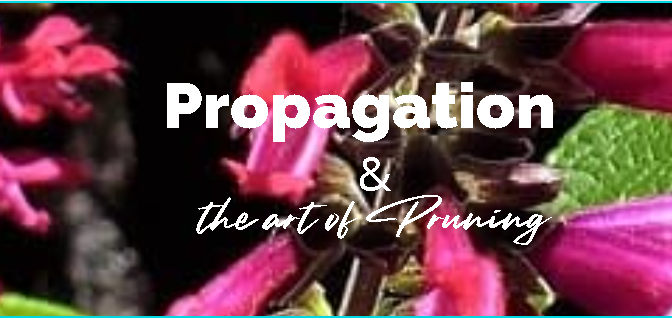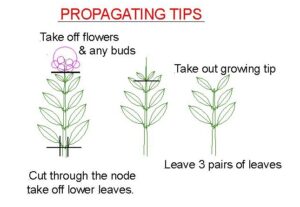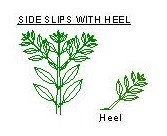How to propagate Salvias is reasonably easy and by taking cuttings it is by far the best and quickest way to obtain multiple plants.

NOTES ON PROPAGATION :
Propagating Salvias can be done by:
- taking tip cuttings
- side shoots
- division
- layering
CUTTINGS
Best times to take cuttings for large leaf varieties, are generally spring, autumn and winter as they don’t transpire as much moisture when it’s cool.
Spring and early summer are the best times for most other varieties, especially the herbaceous Salvias ( before they run up to flower).
Small leaved Salvias are best taken in Spring and Summer or when the sap is “running” If taken in the cooler months, without the correct bottom heat or perlite mix, these small leaf varieties just sit and sulk, so the warmer months are more suitable for these types of Salvias.

Salvia ‘Pink Champagne is just one of the many small leaf varieties that is perfect for tip cuttings.
Tip Cuttings: Tip Cuttings are the young new growth, where stems have not hardened too much (stem flexible without snapping).
Take a cutting approx 10-12cm from the tip, strip the bottom leaves, remove any flower buds and remove the growing tip. This will encourage new shoots, encouraging the plant to become bushy. On large leaf varieties, cut the leaf in half ( again so they don’t transpire too much). Large leaves take up too much space and crowd and shade smaller cuttings, so cutting in half frees up space and light.
Cut through or immediately below the node. This is where you’ll find the growing cells. This is very important in all of the larger growing Salvias as they have hollow stems. If taken internodely, they won’t strike. If the Salvia has long spaces between the nodes, then you’ll need a deeper pot. Some of the small leaved varieties can be cut between the nodes as their stems are still green enough at this stage.
Once you’ve taken your cuttings, put them in water while you finish preparing all the rest of your cuttings ( this keeps them fresh). When ready, dip the cutting into cutting gel/ powder which helps to promote new root growth.
The best cutting mix should be a mix of perlite/ vermiculite and potting soil approx a ratio of 70/30 or 80/20. This will be a dirty mix. The perlite is a mineral and helps to keep the mix aerated. This is really important in the cooler months when cuttings can easily rot. Most cuttings root a lot easier and a lot faster with the use of Perlite.
You can place 1 cutting in a small pot or multiple cuttings in a wider squat pot if you don’t have the room for multiple pots. By cramming lots of cuttings into 1 pot, they all seem to create a micro climate which helps and protects each other.
Place pots in a sheltered position out of the wind or direct sun – this allows them to settle. After a few days, place the small leaved varieties out in a sunny position on to some soil in the garden and keep the large leaved varieties in the shade, again placing them on to some soil. If there is a lack of space in the garden, then place some soil in the base of the tray – Placing the pot of cuttings onto soil seems to help pull the roots down to the bottom of the pot. When roots are showing out of the pot, or the pot is hard to pick up, then it’s time to pot up the plants. Gently tape them out, so you can tease the roots apart gently and carefully. Use a good aerated potting mix which will hold the water in summer but not drown the plant in winter. Pot up individually and feed with a osmocote type of fertiliser.
The cutting mix can be reused time and time again without any contamination or problems to the cuttings.
Side Shoots:
Small side shoots and young growth from the base of the plant can also be taken , this applies to all bushy, herbaceous and tall shrubby species. Often these are best taken with a heal – this is when you carefully break the shoot off the main stem, a small piece of the stem will stay with the shoot – see diagram.
Division: This is done with herbaceous plants that have basal clumps or plants that increase their size from underground stems. These can be divided after winter, when all frosts are over, when the new shoots start to appear. Dig up or tap out the clump from a pot; using a sharp knife or spade, slice the clumps either in half or quarters, depending on size, making sure there are enough shoots and roots to each clump you want to divide and a good quantity of new shoots.
Clean away any dead stems, shoots and roots. Dust the cut area with rooting powder, place in the new position or pot, fill with soil, firm down and water in thoroughly, so now you should have 2 – 4 new plants.

Salvia ‘Pink Marvel’ is a perfect example of a clumping plant producing side shoots and being able to divide the plant into small pieces to increase the number of plants.
Layering: This is an easy way to increase your plants with those Salvias that are naturally procumbent along the ground, or those plants that produce long shoots that can be carefully bent down to the ground.
Some People like to “nick/ wound” the stem, which helps to promote roots at this point, white others just cover a section of stem and wait for it to root, or bury nodes ( or elbows) – these nodes naturally form roots when they touch the ground.
When the stem is well rooted, then the stem can be cut and potted up or planted in the garden.

Salvia ‘Cyclamen’ is such an example of a plant that produces underground stems to expand the clump.
Seeds: While this method may be a good way to increase your stock en masse it is not always the best method if you are wanting a plant variety to come ‘true’. As with all seed, there is always a chance of cross pollination.
Cross pollination can lead to many varied cultivars and hybrids. Not all salvias cross, there are many species that do come true from seed.
Sow seed in Spring to Autumn, in friable soil, sow seed into pots with a very good seed raising mix. Sow seed directly on top of soil, DON’T cover with soil, Salvias need light to germinate. Cover pot with fly wire or plastic cover to protect germinating seed from the ‘Midnight Munches’.
Water either with a dose of Epsom Salts – 1tsp in 1 Lt spray bottle, allow the mixture to dissolve, then spray immediately after sowing, then again once or twice before they germinate. The magnesium helps to overcome the dormancy.
Smokey water is also used to help germination – used in the diluted form Regen 2000 Smoke Master solution from TREEMAX. This is often used by nurseries and the Botanic gardens to over come dormancy in difficult species.


